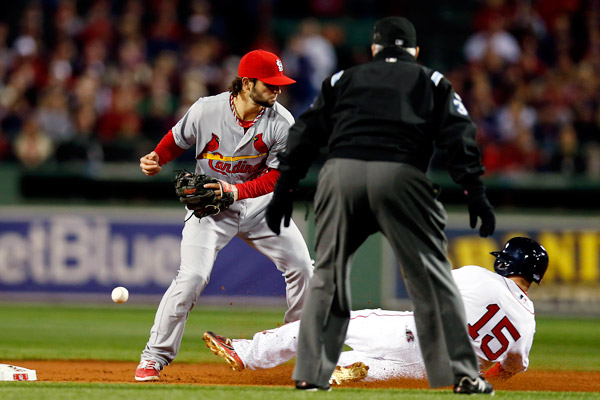Many of the errors officials make happen because they
anticipate a play happening and make the call too early. We had two examples of this in the
World Series just finished (hooray for the Sox!).
In Game 1, umpire Dana DeMuth called “out” on a force play
at second base before he made sure that Cardinals shortstop Pete Kozma had
actually caught the ball. To his
credit, when he saw the ball on the ground, he got help from his partners and
crew chief John Hirschbeck overturned the call.
To be polite, let’s say the post-game press conference was a
well-scripted fiction. DeMuth spun
the situation with all his might to say that he saw the drop happening on the
exchange (taking the ball out of the glove to throw it) instead of saying he
made the call too early, and that he did the right thing by checking to see
whether his partners saw it the same way.
Of course the most important thing is to get the call right, which they
eventually did.
Then in the sixth and final game, I jumped up and started
ranting at the TV when Hirschbeck rushed his “safe” call on the botched
Cardinal rundown of Jacoby Ellsbury.
You’ll see on the replay that Hirschbeck made his call as soon as he saw
the missed tag, and didn’t wait until Ellsbury got back to the base
safely.
The official instructions to umpires are clear: “Do not come running with your arm up or down, denoting ‘out’ or ‘safe.’ Wait until the play is completed before making any arm motion.” In this situation, the absence of an “out” call sufficiently communicates that there was no tag.
The official instructions to umpires are clear: “Do not come running with your arm up or down, denoting ‘out’ or ‘safe.’ Wait until the play is completed before making any arm motion.” In this situation, the absence of an “out” call sufficiently communicates that there was no tag.
Holding the call is something I remind myself about every game. What I lack in skating speed I try to
make up for with situational awareness, which is the ability to identify and
react to a situation as it develops.
Where situational awareness gets you in trouble is when unexpected
things happen, like the shortstop dropping the ball or an attacker with the
puck holding up at the blue line instead of bringing the puck over. If you’ve wound up for a bang-bang
offsides call when the puck is still on the blue line, you’ll look like a fool.
Like a lot of other things that happen in sports, there are life lessons there if you pay attention. Making decisions in haste is the way to make more wrong decisions. No wrong decisions in the puzzle lineup this weekend, though.
The Wall Street Journal has a real treat: “Choices”: a variety cryptic by Hex with a quite novel grid. Be warned it’s harder than most weekend Journal puzzles, but worth your effort. 31a and 8d are pretty obscure: trust the wordplay. The solution is posted elsewhere on the blog.
Hex also have their weekly straight cryptic in the National Post, solved and annotated for you by Falcon. I heard half a theme in there about music; it would have been nice for Hex to theme more of the clues.
An uncommon straight bar cryptic is Tom Toce’s latest, published in the new issue of Contingencies. “No Bells, No Whistles” would be the antithesis of the Mitchell Sunday, as I referee and The Other Doctor Mitchell rings in the handbell choir. Note a minor printer’s error in that puzzle: there should be another bar immediately under the square numbered 27.
This weekend’s New York Times puzzle (behind the paywall) is an acrostic by Hex, and the monthly bonus puzzle for subscribers is also up: it’s a Fred Piscop puzzle for National Novel Writing Month.
And catching up with Kevin Wald, here’s another small puzzle of his: themed as usual. Amazing how many puzzles he creates when there must be a lot of work going into each one.
Bonus puzzle: Rock fans should know that BEQ composed a straight crossword in memory of Lou Reed.
Nathan Curtis’s site had a few technical problems last weekend, but it’s working all right now. No new puzzles yet though. Xanthippe is feeling emboldened so she is busy creating another new one.


I used to umpire Little League. One day I was working the 13-15 year-olds' league. For most of the kids this was their first time playing on a 90 ft. diamond, and the first time with the dropped third strike rule. This catcher dropped a third strike, the batter started to run, but then stopped for no good reason, looking confused. The catcher at last located the ball and trotted to the batter. Holding the ball in his bare hand he tagged the batter with his gloved hand (separate from the ball). This is not a legal tag, so my partner and I made no call. This led to a lot of standing around and staring--the catcher not knowing what he did wrong, the batter having the suspicion he should be doing something, but not sure what yet, and everyone else scratching their heads.
ReplyDeleteSensing something ought to be done, I held my arms out wide. The batter then realized he wasn't yet out but also not on a base, so he started running to first. Seeing his quarry get away, the catcher threw to the first baseman in plenty of time for the putout. Now I called him out.
I still think I did the right thing. We might have been there a lot longer...